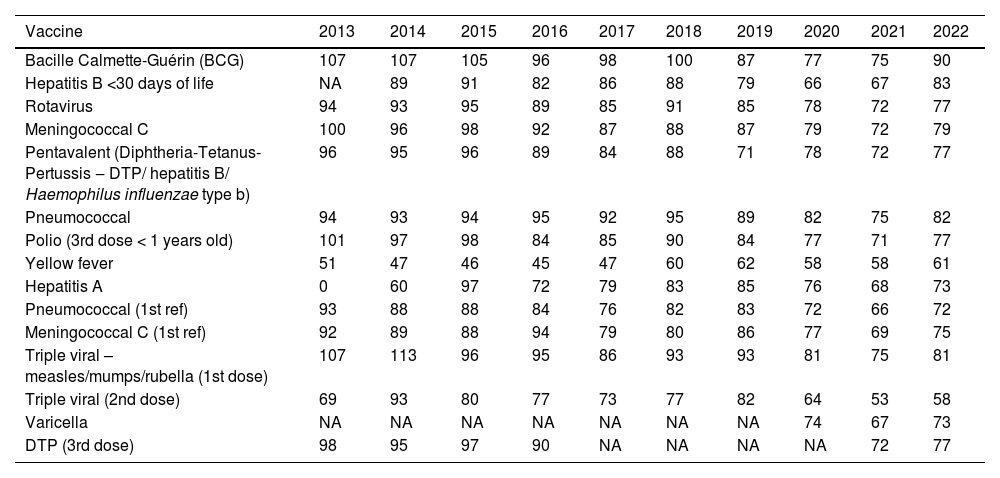The Brazilian National Immunization Program (NIP), coordinated by the Ministry of Health in cooperation with the state and municipal health departments, was created in 1973 and strengthened by the successful campaign of Smallpox Eradication campaign. The program has made many achievements in its history, which are attributed to the fact that the NIP follows the doctrinal principles of the Unified Health System: universality, equity of assistance, and organizational principle of decentralization. The Brazilian NIP was successful based on effective communication campaigns. Another positive aspect of achieving the goal of high vaccination coverage in Brazil during the last few years has been having national laboratories that produce vaccines of excellent effectiveness, quality, and competence, making the national program more accessible and cost effective. This represents an efficient public policy that has a significant impact on the morbidity and mortality profiles of the Brazilian population, adapting to changes in the country's political, epidemiological, and social fields. In this context, the country registered the elimination of poliomyelitis, as well as the elimination of rubella and congenital rubella syndrome, and neonatal tetanus. In addition, thousands of Brazilians have stopped getting sick from vaccine-preventable diseases because of immunization actions.1,2
In recent years, the NIP has been facing a critical challenge: the reduction in the achievement of the recommended targets for vaccination coverage rates, mainly from 2016 (Table 1), and aggravated by the COVID-19 pandemic, a period in which there was a gradual decline from 10% to 20%.3–5 In September 2022, The Pan American Health Organization (PAHO) stated that Brazil, the Dominican Republic, Haiti, and Peru are at very high risk for the reintroduction of poliomyelitis, as dwindling vaccination rates during the coronavirus pandemic have led to historic lows in protection against the disease.6 Correspondingly, reduced vaccination rates leave the country susceptible to other preventable diseases, such as measles, meningitis, and invasive pneumococcal diseases.4
Vaccination Coverage (%). Brazil, 2013 to 2022.
NA, not available.
Source: National Immunization Program Information System (updated on 05/26/2023).3
Some factors can explain this situation.
A study aimed at evaluating the spatial dynamics of the vaccination coverage rate of children <1 year old by a municipality in Northeast Brazil in 2016 and 2017 demonstrated the existence of geographic areas and clusters with low rates.7 Another study showed low vaccination coverage associated with socioeconomic inequalities that still prevail in the Brazilian Amazon, such as poverty (aOR = 2.12, 95% CI 1.06–4.21), low maternal schooling (aOR = 2.60, 95% CI 1.28–5.29), and time of residence of the child in the urban area of the city (aOR = 0.73, 95% CI 0.55–0.95).8
One of the main concerns in the country is vaccination hesitation, which is old in Europe and the United States and is growing increasingly. Vaccination hesitation is defined as a “delay in accepting or refusing recommended vaccines despite their availability in health services”.9 During the COVID-19 pandemic, we lived with a veritable epidemic of deliberate or accidental misinformation, which contributed significantly to increasing the risk of infection and promoting distrust in vaccines. Fake vaccine news is a crucial target of the anti-vaccine movements, making the hyperconnected Brazilian population an easy prey. The most susceptible digital Brazilians failed to recognize the logical differences between fake and accurate news.10
The data presented show that several actions are necessary for the country to regain its prominent position in decades, with high vaccination coverage. First, having a plan for activities directed toward each region according to its needs is fundamental. Second, we need to clarify that the lack of risk perception of infectious diseases does not mean the absence of risk of reintroduction of vaccine-preventable diseases. Third, the population needs correct information emphasizing the benefits, efficacy, and safety of immunizers to dispel fear of adverse effects and regain confidence in vaccines. Before everything is too late, BRAZIL NEEDS TO BE VACCINATED!





